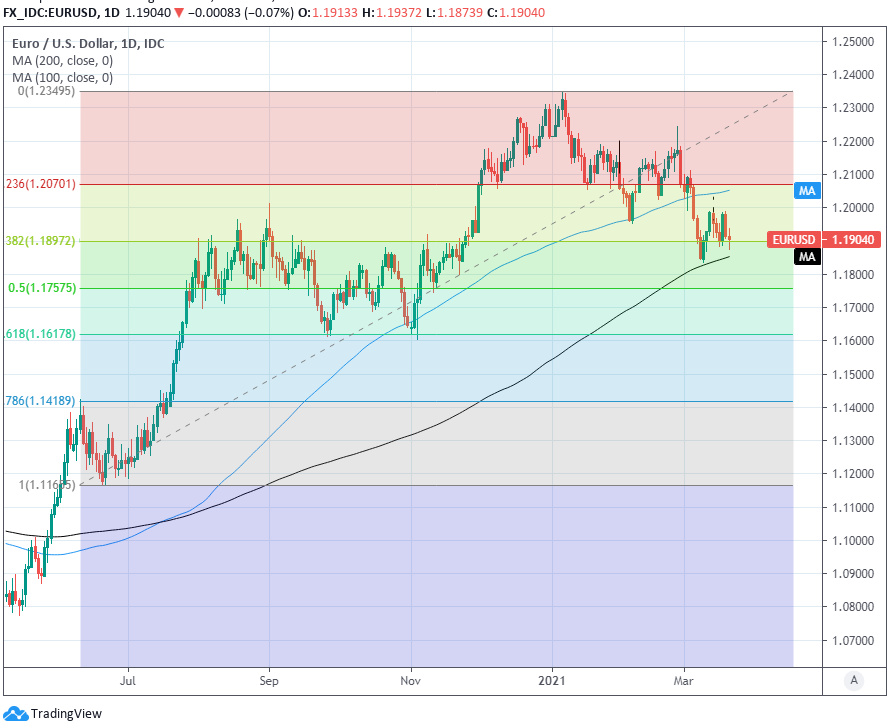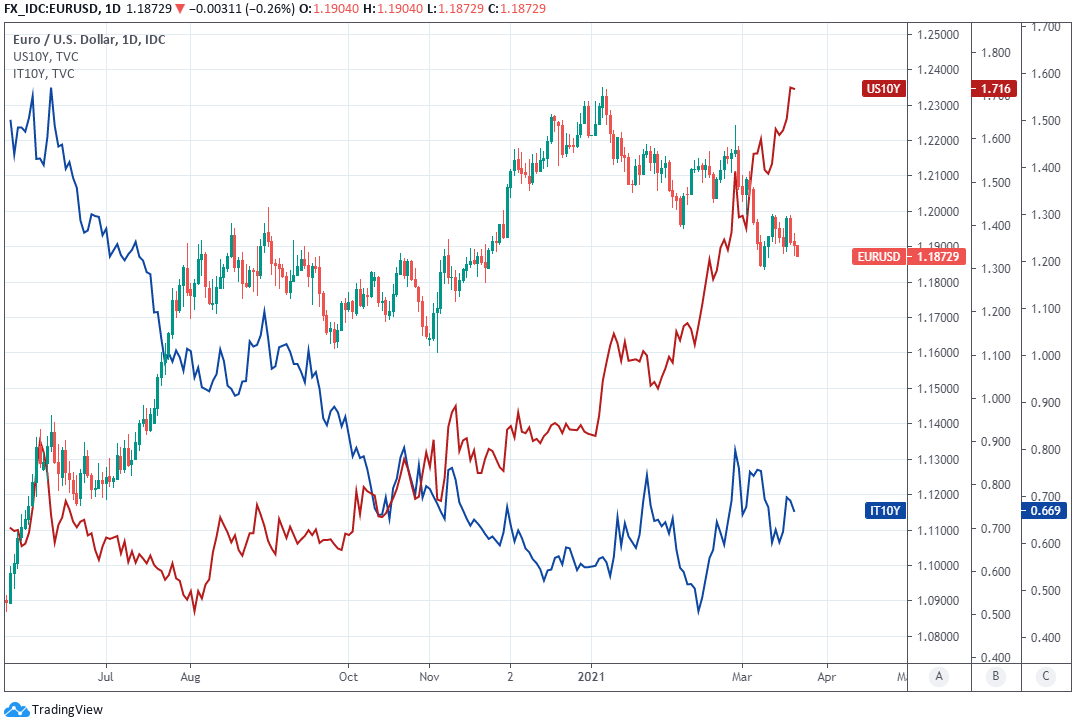Euro-Dollar Week Ahead Forecast: Big Trouble for Turkish Lira Risks A Dash for Euro and Dollar Cash
- Written by: James Skinner
-
- EUR/USD upside volatility ahead as big trouble looms over Lira.
- CBRT Gov fired over rate hike; TRY losses may lift EUR 'funder'.
- But EU virus woe assures swift suppression when dust settles.
- 200-day average at 1.1850 offers solid support before 1.1750.

File Image © Adobe Stock. Webpage Image © Central Bank of the Republic of Turkey, CBRT. Former Governor Naci Ağbal.
- EUR/USD spot rate at time of writing: 1.1904
- Bank transfer rate (indicative guide): 1.1505-1.1590
- FX specialist providers (indicative guide): 1.1702-1.1799
- More information on FX specialist rates here
- Set an exchange rate alert here
The Euro-to-Dollar exchange rate has defied its doubters as well as a resurgent U.S. Dollar in recent weeks and could now have material upside ahead of it from Sunday's open in what will likely be volatile trading as the latest developments at the Turkish central bank threaten to plunge the Lira back into crisis.
Europe's unified unit has been the market's preferred 'funding currency' since January when European Central Bank (ECB) pushback against a rallying Euro saw the speculative community fall out of love with the Euro-Dollar, though this has a flipside in market conditions such as those likely ahead.
Euros were sold for higher-yielding commodity and emerging market currencies this year in a process that involved EUR/USD and which the Lira was a significant beneficiary of due to November's policy u-turn from the Central Bank of the Republic of Turkey (CBRT) under then-Governor Naci Ağbal.
"The Turkish lira may easily sell-off 10-15%, with 7.50, 7.79 and 8.00 vs. USD easily achievable. We will see this start on Monday, when Asia trading kicks in," Cristian Maggio, head of emerging market strategy at TD Securities. "Turkish authorities will try to lean against this move, likely deploying an array of measures. They may be somewhat effective for a start, but we question their ability to be successful for long in the current environment. The best course of action for now is likely to buy USDTRY."
Governor Ağbal, a former finance minister appointed in November to rehabilitate Turkish monetary policy and pull the Lira from a mire of perpetual devaluation and crisis, was fired at the weekend in an apparent political response to last week's interest rate hike to 19%.

Above: Euro-to-Lira exchange rate shown at daily intervals with USD/TRY (red) and GBP/TRY (yellow).
" President Erdogan had not approved the move and, therefore, removed Naci Agbal from office by presidential decree in the morning of Saturday (20 March)," Maggio says. "We doubt Kavcioglu would last in office very long if the lira goes into another tailspin - a very likely scenario ahead."
Ağbal has been replaced by Sahap Kavcioglu, a former lawmaker of the governing party who's frequently penned articles in the Yeni Şafak newspaper criticising the about-turn in monetary policy; the sole driver of near-20% declines in USD/TRY and EUR/TRY seen since November.
Those gains could begin unravelling promptly from the open on Sunday, analysts say, and although a rising USD/TRY is typically the main instrument of Lira depreciation the Euro's 2021 use by investors as a source of funding for bets on emerging markets will likely generate at least some automatic Euro buybacks as the Turkish currency is sold.
"The Central Bank of the Republic of Turkey will continue to use the monetary policy tools effectively in line with its main objective of achieving a permanent fall in inflation," Kavcioglu said in his first statement as Governor.
{wbamp-hide start} {wbamp-hide end}{wbamp-show start}{wbamp-show end}
Investors who bought the Lira for high and rising yields could be likely to exit those bets from Sunday and there's a chance such investors initially paid for the Turkish unit using low-yielding 'funding currencies' like the Euro, Swiss Franc and Japanese Yen in what is known as a "carry trade."
Market mechanics require investors to sell Lira for Dollars and then Dollars for Euros, Yen or Swiss Francs in order to exit some such wagers so the Lira's troubles could lead to a flash in the pan Euro-Dollar rally early this week.
"We will not turn bullish on TRY as long as Erdogan is effectively running the central bank, and renewed TRY-bulence is by the way a bigger issue for EUR than USD," says Martin Enlund, chief FX strategist at Nordea Markets. "We remain short EUR vs. smarter vaccine peers such as the US and the UK."
Any meaningful gains are likely to be suppressed quickly once the dust settles however, given the deteriorating virus and vaccination situation in Europe.
Above: Euro-Lira with EUR/USD (blue), USD/TRY (red) and GBP/TRY (yellow) during 2018 Turkish currency turmoil.
"Europe’s handling of the Covid-19 crisis certainly seems to be taking its toll on the EUR. Third waves now look a reality for the likes of France, the Netherlands and Italy, triggering fresh lockdowns and delaying the day when Europe can play its part in the global recovery," says Chris Turner, global head of markets and regional head of research at ING. "A revisit to the 200-day moving average, now at 1.1855, again looks the bias. Yet we see this as a temporary correction as Europe muddles through and still believe a supportive risk environment can drag EUR/USD well back above 1.20 later this month and into April."
Rising infections have seen large parts of Italy and France return to 'lockdown' while Germany has warned of prolonged restrictions and Swiss authorities scrapped plans to reopen further until progress is made on vaccinations that are yet to get underway. Meanwhile countries that have led the vaccination race, like Israel, the UK and U.S., could potentially reopen shuttered parts of their economies months before Europe. This is the outlook for growth and central bank policy in Europe diverging from the others which is increasingly noted as a driver of exchange rates, although EUR/USD has proven remarkably resilient.
"EUR/USD has again backed away from resistance offered by 1.2014 (September high) and while capped here near term risks remain on the downside. Support remains the 200 day ma and last weeks low at 1.1850/35, failure here will target 1.1750," says Karen Jones, head of technical analysis for currencies, commodities and bonds at Commerzbank, who tips EUR/USD to oscillate around 1.1950 for the near-term ahead of a run at its 1.2635 200-week moving-average over the next sinx months.
Headwinds resulting from the vaccine troubles and a third wave of infections have, combined with a rally in U.S. bond yields, already compelled the ECB to bring forward bond purchases under its quantitative easing programme to prevent borrowing costs rising too far for comfort.
Above: Euro-Dollar with Fibonacci retracements of June 2020 rally, 200-day average (black) & 100-day average (blue).
In other words the ECB is squashing European yields just as an economic recovery threatens to sustain a doubling of the 10-year U.S bond yield.
"Despite reassurances that the inflation that will be seen in the months ahead will be transitory, the market appears to be having a hard time reconciling how the huge fiscal spend in the US cannot impact inflation prospects and Fed policy. While we continue to expect the Fed to battle markets in the months ahead to push through the message that its policy will remain extremely accommodative, market optimism in the US reflation trade is likely to ensure USD retains a resilient tone," says Jane Foley, a senior strategist at Rabobank. "Given also concerns about the economic impact of the slow vaccine roll-out in the EU, we have lowered our EUR/USD forecast and now see the currency pair at 1.18 on a 12 month view."
U.S. yields have surged amid improving growth expectations and investor wagers the Federal Reserve (Fed) could lift interest rates as soon as 2022, a notion the bank has pushed back against all the while shrugging off the yield moves in the bond market. The bank has plenty of opportunity to have its voice heard again this week given no less than 20 speeches or other appearances from rate setters including two in Congress by Chairman Jerome Powell.
However, it's not just U.S. rate setters which are out on the speaking circuit this week however, as ECB President Christine Lagarde is also set to appear at an online event hosted by Project Syndicate, the European Investment Bank, and the European Commission at 15:40 London time on Wednesday.
Lagarde will then address an online event hosted by the Bank for International Settlements on Thursday at 09:30. Thursday also marks the beginning of the latest EU economic summit, which runs through Friday and will see national leaders discuss recovery plans, although it's not clear if the Euro can expect even any proposals of further financial support for Eurozone's economies some of which are now facing months more lived under draconian restrictions.
Above: Euro-Dollar shown at daily intervals with 10-year U.S. government bond yield (red) and 10-year Italian yield (blue).









